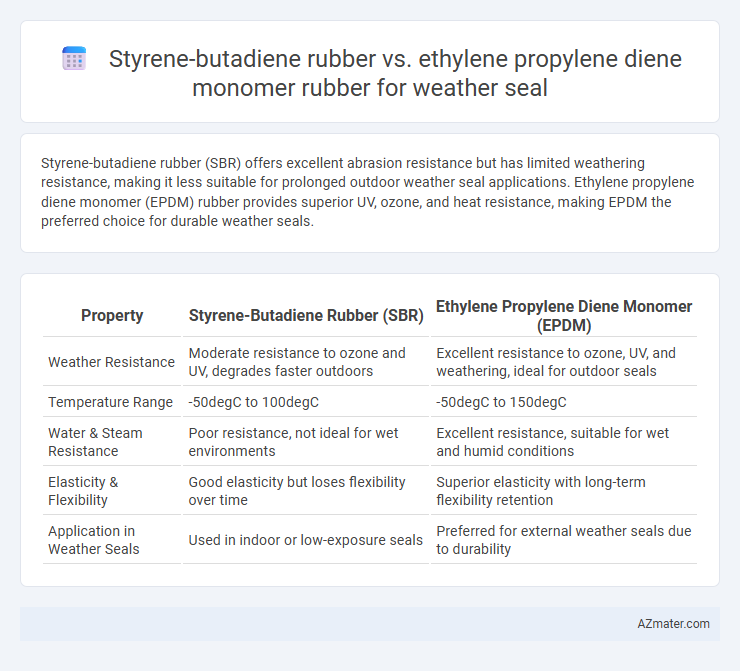Styrene-butadiene rubber (SBR) offers excellent abrasion resistance but has limited weathering resistance, making it less suitable for prolonged outdoor weather seal applications. Ethylene propylene diene monomer (EPDM) rubber provides superior UV, ozone, and heat resistance, making EPDM the preferred choice for durable weather seals.
Table of Comparison
| Property | Styrene-Butadiene Rubber (SBR) | Ethylene Propylene Diene Monomer (EPDM) |
|---|---|---|
| Weather Resistance | Moderate resistance to ozone and UV, degrades faster outdoors | Excellent resistance to ozone, UV, and weathering, ideal for outdoor seals |
| Temperature Range | -50degC to 100degC | -50degC to 150degC |
| Water & Steam Resistance | Poor resistance, not ideal for wet environments | Excellent resistance, suitable for wet and humid conditions |
| Elasticity & Flexibility | Good elasticity but loses flexibility over time | Superior elasticity with long-term flexibility retention |
| Application in Weather Seals | Used in indoor or low-exposure seals | Preferred for external weather seals due to durability |
Introduction to Automotive Weather Seals
Styrene-butadiene rubber (SBR) offers excellent abrasion resistance and aging stability ideal for automotive weather seals exposed to mechanical wear. Ethylene propylene diene monomer (EPDM) rubber provides superior ozone, UV, and weathering resistance, making it highly effective in maintaining seals against environmental degradation. Both materials are crucial in automotive weather seals, with EPDM commonly preferred for external door and window seals due to its outstanding resilience to harsh weather conditions.
Overview of Styrene-Butadiene Rubber (SBR)
Styrene-butadiene rubber (SBR) is a synthetic elastomer widely used in weather seals due to its excellent abrasion resistance and moderate resistance to heat and aging, making it suitable for outdoor applications. SBR offers good tensile strength and flexibility, but it has limited resistance to ozone and UV exposure compared to Ethylene Propylene Diene Monomer (EPDM) rubber. Cost-effectiveness and availability make SBR a common choice for seals requiring durability under moderate environmental stress.
Overview of Ethylene Propylene Diene Monomer (EPDM) Rubber
Ethylene Propylene Diene Monomer (EPDM) rubber is a highly durable synthetic elastomer known for exceptional resistance to weathering, ozone, UV rays, and temperature extremes, making it ideal for weather seals in automotive and construction applications. EPDM exhibits excellent flexibility and long-term performance in outdoor environments compared to Styrene-Butadiene Rubber (SBR), which tends to degrade faster under prolonged exposure to sunlight and ozone. Its superior water resistance and ability to maintain elasticity in both high and low temperatures ensure reliable sealing against moisture and environmental elements.
Key Material Properties: SBR vs EPDM
Styrene-butadiene rubber (SBR) offers excellent abrasion resistance and tensile strength, making it suitable for applications requiring durability and wear resistance. Ethylene propylene diene monomer (EPDM) excels in weather resistance, ozone resistance, and thermal stability, providing superior performance in outdoor and harsh environmental conditions. For weather seal applications, EPDM's resistance to UV rays, oxygen, and extreme temperatures generally makes it the preferred material over SBR.
Weather Resistance: Performance Comparison
Styrene-butadiene rubber (SBR) exhibits moderate weather resistance with vulnerability to ozone and UV degradation, making it less ideal for prolonged outdoor exposure in weather seals. Ethylene propylene diene monomer (EPDM) rubber demonstrates superior weather resistance due to its excellent ozone, UV, and heat stability, ensuring reliable long-term performance in harsh environmental conditions. EPDM's molecular structure provides enhanced durability against oxidation and cracking, which is critical for effective weather sealing applications.
Ozone and UV Stability: SBR vs EPDM
Styrene-butadiene rubber (SBR) exhibits moderate resistance to ozone and UV exposure, often requiring additives for improved durability in weather seal applications. Ethylene propylene diene monomer (EPDM) rubber offers superior ozone and UV stability due to its saturated backbone and ethylene-propylene copolymer structure, making it a preferred choice for long-term outdoor weather seals. EPDM's resistance reduces cracking and degradation, ensuring enhanced performance and longevity compared to SBR in harsh environmental conditions.
Durability and Longevity in Weather Seals
Styrene-butadiene rubber (SBR) offers moderate durability and resistance to abrasion, making it suitable for weather seals exposed to mechanical wear but less effective under prolonged UV and ozone exposure. Ethylene propylene diene monomer (EPDM) rubber excels in weather seal applications due to its superior resistance to UV radiation, ozone, oxidation, and extreme temperatures, resulting in significantly enhanced longevity. EPDM's stable polymer structure ensures prolonged elasticity and durability in outdoor environments, outperforming SBR in maintaining seal integrity under harsh weather conditions.
Cost and Manufacturing Considerations
Styrene-butadiene rubber (SBR) offers a cost-effective option for weather seals with straightforward manufacturing processes, suitable for high-volume production. Ethylene propylene diene monomer (EPDM) rubber, while generally higher in cost, provides superior resistance to UV, ozone, and extreme weather conditions, justifying its use in long-lasting seals despite more specialized processing requirements. The choice between SBR and EPDM hinges on balancing initial material costs and manufacturing complexity against the specific environmental durability needs of the application.
Common Applications in the Automotive Industry
Styrene-butadiene rubber (SBR) is widely used in automotive weather seals due to its excellent abrasion resistance and good aging properties, making it ideal for door seals and window gaskets. Ethylene propylene diene monomer (EPDM) rubber offers superior resistance to ozone, UV rays, and extreme temperatures, which ensures long-lasting performance in exterior automotive weather seals such as trunk and hood seals. Both materials are essential in automotive manufacturing, with SBR preferred for dynamic sealing applications and EPDM excelling in harsh environmental exposure conditions.
Conclusion: Choosing the Right Rubber for Weather Seals
Styrene-butadiene rubber (SBR) offers excellent abrasion resistance and cost-effectiveness, making it suitable for general weather sealing applications in moderate environments. Ethylene propylene diene monomer (EPDM) rubber provides superior weather, ozone, and UV resistance, ensuring longer durability in harsh outdoor conditions. Selecting EPDM is ideal for weather seals exposed to extreme weather, while SBR fits well for less demanding applications requiring economic efficiency.

Infographic: Styrene-butadiene rubber vs Ethylene propylene diene monomer rubber for Weather seal
 azmater.com
azmater.com